1988 Pacific typhoon season
| 1988 Pacific typhoon season | |
|---|---|
|
Season summary map | |
| Seasonal boundaries | |
| First system formed | January 7, 1988 |
| Last system dissipated | December 27, 1988 |
| Strongest storm | |
| Name | Nelson |
| • Maximum winds |
185 km/h (115 mph) (10-minute sustained) |
| • Lowest pressure | 915 hPa (mbar) |
| Seasonal statistics | |
| Total depressions | 52 |
| Total storms | 31 official, 1 unofficial |
| Typhoons | 11 |
| Super typhoons | 1 |
| Total fatalities | >786 |
| Total damage | > $503.9 million (1988 USD) |
| Related articles | |
The 1988 Pacific typhoon season has no official bounds; it ran year-round in 1988, but most tropical cyclones tend to form in the northwestern Pacific Ocean between May and November.[1] These dates conventionally delimit the period of each year when most tropical cyclones form in the northwestern Pacific Ocean. Tropical Storms formed in the entire west Pacific basin were assigned a name by the Joint Typhoon Warning Center. Tropical depressions that enter or form in the Philippine area of responsibility are assigned a name by the Philippine Atmospheric, Geophysical and Astronomical Services Administration or PAGASA. This can often result in the same storm having two names.
A total of 26 tropical cyclones formed this year in the Western Pacific, of which all became tropical storms. Of the 26, 10 storms reached typhoon intensity, of which 1 reached supertyphoon strength. Nine tropical cyclones moved through the Philippines this season, making this season the most active for the archipelago so far this decade.
Systems
A total of 26 tropical cyclones formed this year in the Western Pacific, of which all became tropical storms. Of the 26, 10 storms reached typhoon intensity, of which 1 reached supertyphoon strength. Nine tropical cyclones moved through the Philippines this season.

Typhoon Roy (Asiang)
| Typhoon (JMA) | |
| Category 4 typhoon (SSHWS) | |
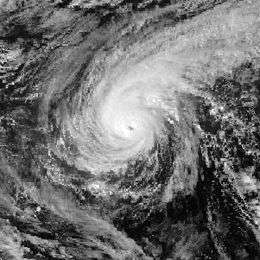 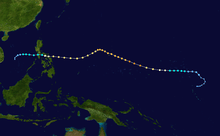 | |
| Duration | January 7 – January 19 |
|---|---|
| Peak intensity | 155 km/h (100 mph) (10-min) 940 hPa (mbar) |
Typhoon Roy, which crossed the open Western Pacific as a Category 4 typhoon in January, caused moderate to extensive damage across the Federated States of Micronesia and the Philippines, causing $23.5 million (1988 USD) but only one death.
Typhoon Susan (Biring)
| Typhoon (JMA) | |
| Category 1 typhoon (SSHWS) | |
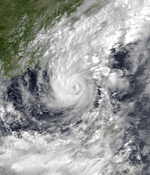  | |
| Duration | May 28 – June 3 |
|---|---|
| Peak intensity | 120 km/h (75 mph) (10-min) 970 hPa (mbar) |
Typhoon Susan formed at the end of May just to the north of Luzon Island in the Philippines. As a depression Susan dropped heavy rains in and around the Manila area the resulting landslides killed 6 people. As Susan moved away from the Philippines the storm strengthened into a typhoon shortly before cross in the southern tip of Taiwan and turning extratropical just after passing Okinawa.[2]
Tropical Storm 03W (Konsing)
| Tropical storm (JMA) | |
| Tropical depression (SSHWS) | |
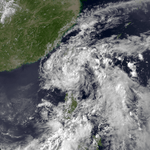  | |
| Duration | June 3 – June 6 |
|---|---|
| Peak intensity | 65 km/h (40 mph) (10-min) 1000 hPa (mbar) |
3W was quick fire tropical storm.
Typhoon Thad (Ditang)
| Typhoon (JMA) | |
| Category 1 typhoon (SSHWS) | |
 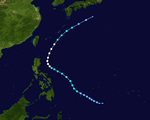 | |
| Duration | June 17 – June 25 |
|---|---|
| Peak intensity | 130 km/h (80 mph) (10-min) 970 hPa (mbar) |
A tropical depression was designated by the JMA early on June 18. At the time, the depression was located south of the Caroline Islands.[3] Further development was slow to occur due to strong winds aloft caused by a TUTT. Nevertheless, the system's cloud structure and outflow pattern slowly improved, and based on Dvorak estimates of T2.5/40 mph (65 km/h), the JTWC upgraded the disturbance into Tropical Storm Thad at 00:00 UTC on June 20,[4] with the JMA following suit six hours later.[3] After initially moving west, Thad tracked northwest due to the subtropical ridge to its north. Thad slowly deepened,[4] with the JMA upgrading Thad to a severe tropical storm at 06:00 UTC on June 21 and a typhoon the next day.[3] At 06:00 UTC on June 22, the JTWC upped Thad into a typhoon, based on satellite intensity estimates of 130 km/h (80 mph).[4] Shortly thereafter, the JMA reported that Thad reached its highest intensity, with winds of 130 km/h (80 mph).[3] Additional strengthening did not occur, however, as the system developed a central cold over – a large irregular shaped area of deep convection. By June 23, Thad reached the western periphery of a subtropical ridge, and began to recurve in response to a mid-latitude trough over eastern China. Rapid weakening began at 00:00 UTC on June 24 due to increased winds aloft. Both the JTWC[4] and JMA downgraded Thad into a tropical storm that day as the storm passed 150 km (95 mi) southeast of Okinawa.[3] The JTWC reported that Thad dissipated at 00:00 UTC on June 25,[4] although the JMA continued to track it as a tropical depression for 12 more hours.[3]
Severe Tropical Storm Vanessa (Edeng)
| Severe tropical storm (JMA) | |
| Tropical storm (SSHWS) | |
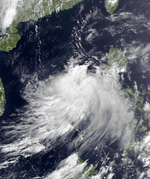  | |
| Duration | June 25 – June 29 |
|---|---|
| Peak intensity | 100 km/h (65 mph) (10-min) 990 hPa (mbar) |
A tropical disturbance was first spotted at noon in June 24 over 200 km (125 mi) east of the Caroline Islands. Thunderstorm activity increased almost immediately thereafter, and the storm's outflow subsequently expanded, aided by a retreating Tropical Upper Tropospheric Trough (TUTT).[4] The JMA upgraded the system into a tropical depression on the morning of June 26.[3] Six hours later, the JTWC followed suit, and at 00:00 UTc on June 27, both the JTWC and JMA upgraded the depression into a tropical storm.[4] Several hours later, Vanessa made landfall over the central Philippines; at the time of landfall, both the JMA and JTWC estimated winds of 80 km/h (50 mph).[4][3] Accelerating, Vanessa entered the South China Sea at 02:00 UTC on June 28.[4] Around this time, the JMA estimated that Vanessa reached its maximum intensity, with winds of 105 km/h (65 mph), making it a severe tropical storm.[3] Strong wind shear then increased over the system, but Vanessa did not begin weakening until 00:00 UTC on June 29. Six hours later, after Vanessa became devoid of deep convection near the center, the JTWC issued their last warning on the system.[4] However, the JMA continued to track it until noon that day.[3]
Typhoon Warren (Huaning)
| Typhoon (JMA) | |
| Category 4 typhoon (SSHWS) | |
  | |
| Duration | July 11 – July 20 |
|---|---|
| Peak intensity | 165 km/h (105 mph) (10-min) 940 hPa (mbar) |
A tropical depression formed to the east of Guam shortly before passing north of the island. Shortly after passing the island the storm strengthened into Tropical Storm Warren. Warren kept gathering strength and reached peak intensity of 135 mph while 300 miles east of Luzon Island. Typhoon Warren moved westward and brushed the extreme northern tip of Luzon Island in the Philippines causing $10 million in damage. Warren then made landfall near Shantou, China, 13,000 homes were destroyed and 17 people were killed in Guangdong Province.[2]
Severe Tropical Storm Agnes
| Severe tropical storm (JMA) | |
| Tropical storm (SSHWS) | |
  | |
| Duration | July 27 – August 1 |
|---|---|
| Peak intensity | 95 km/h (60 mph) (10-min) 975 hPa (mbar) |
Following the demise of Typhoon Warren, an area of disturbed weather formed southeast of Japan, and by July 27, this area had developed a closed surface circulation.[4] At noon the same day, the JMA upgraded it into a tropical depression.[3] Initially resembling a monsoon depression, the storm's upper-level outflow and organization increased on June 28 in response to decreased winds aloft.[4] On June 29, both the JTWC and JMA upgraded the system into Tropical Storm Agnes.[4][3] Contrary to forecasts, Agnes accelerated northeast in response to a trough northeast of Japan.[4] At 00:00 UTC on June 30, the JTWC estimated a peak intensity of 80 km/h (50 mph) and the JMA estimated a peak intensity of 95 km/h (60 mph), making Agnes a severe tropical storm.[4][3] Twelve hours later, the system lost all its deep convection, and the JTWC issued its last warning on it at 18:00 UTC.[4] Despite this, the JMA continued to follow Agnes through October 4, three days after the agency declared Agnes extratropical.[3]
Tropical Storm Eight
| Tropical storm (JMA) | |
 | |
| Duration | July 30 – August 3[4] |
|---|---|
| Peak intensity | 65 km/h (40 mph) (10-min) 998 hPa (mbar) |
This was not tracked by the JTWC.
Tropical Storm Bill (Isang)
| Tropical storm (JMA) | |
| Tropical storm (SSHWS) | |
  | |
| Duration | August 4 – August 9 |
|---|---|
| Peak intensity | 85 km/h (50 mph) (10-min) 985 hPa (mbar) |
On August 1, the monsoon trough stretched from the Gulf of Tonkin to Japan, but four days later, abruptly re-aligned. This created favorable conditions aloft for tropical cyclone formation,and as such, an area of convection in the Philippine Sea began to rapidly develop.[4] On the evening of August 4, the JMA upgraded the disturbance into a tropical depression,[3] and the next day, the JTWC issued a Tropical Cyclone Formation Alert (TCFA). However, its development rate slowed as the system separated from the monsoon trough. Tracking northeast, the low passed just southwest of the southern tip of Okinawa at 15:00 UTC on August 6.[4] That day, the JMA upgraded the depression into a tropical storm, though the JTWC did not do the same until 24 hours later.[3] Shortly thereafter, both agencies indicated that Bill attained its peak velocity of 80 km/h (50 mph),[4] an intensity it would maintain until making landfall 220 km (135 mi) south of Shanghai. Although the JTWC issued its final advisory at 00:00 UTC on August 8,[4] with the JMA doing the same 36 hours later, its remains could still be identified through August 10.[3]
Tropical Storm Bill, which formed on August 5 east of Taiwan, moved northwest to hit eastern China as a 45 mph tropical storm. Torrential rains and heavy flooding resulted in 110 casualties and widespread damage to roads and dams.[5]
Tropical Storm Clara
| Tropical storm (JMA) | |
| Tropical storm (SSHWS) | |
  | |
| Duration | August 5 – August 16 |
|---|---|
| Peak intensity | 75 km/h (45 mph) (10-min) 994 hPa (mbar) |
An area of disorganized convection about 1,000 km (620 mi) north of Wake Island in early August.[4] The disturbance was classified on August 5 by the JMA.[3] The depression tracked westward under the influence of a subtropical ridge. Two days later, the system began to organize, although shower activity remained exposed from the center. Strong wind shear prevented further development, but by August 10, thunderstorm activity had increased in coverage. At 19:15 UTC the same day, the JTWC upgraded it to Tropical Storm Clara,[4] with the JMA following suit around the same time.[3] Due to a strengthening ridge, Kevin performed a counterclockwise loop, only to turn northeast on August 11.[4] Around this time, the JTWC and JMA estimated that Clara attained peak winds of 80 km/h (50 mph) and 70 km/h (45 mph).[4][3] Shortly afterwards, shower activity quickly became displaced from the deep convection, prompting a weakening trend. The JTWC issued its final warning on August 12,[4] though the JMA did not following suit until four days later.[3]
Tropical Storm Eleven
| Tropical storm (JMA) | |
 | |
| Duration | August 13 – August 18 |
|---|---|
| Peak intensity | 65 km/h (40 mph) (10-min) 1000 hPa (mbar) |
This was not tracked by the JTWC.
Typhoon Doyle
| Typhoon (JMA) | |
| Category 4 typhoon (SSHWS) | |
  | |
| Duration | August 13 – August 24 |
|---|---|
| Peak intensity | 165 km/h (105 mph) (10-min) 930 hPa (mbar) |
On August 12, an westward-moving area of disturbed weather developed within the monsoon trough.[4] Deep convection developed near the low-level center on the next day, and the JMA classified the disturbance as a tropical depression.[3] Overnight August 13 into August 14, the depression began to organize, and after performing a counterclockwise loop, it began moving to the west-northwest.[4] At 18:00 UTC the same day, the JMA upgraded the depression into a tropical storm,[3] though the JTWC did not follow suit until 18 hours later. Doyle then entered a period of rapid deepening,[4] with the JMA upgrading Doyle into a typhoon on the morning of August 16.[3] At 18:00 UTC, the JTWC estimated that Doyle attained peak winds of 210 km/h (130 mph),[4] although according to the JMA, Doyle did not reach its peak intensity of 170 km/h (105 mph).[3] The typhoon then curved north as it rounded a subtropical ridge, although unlike most recurving tropical cyclones, a TUTT cell prevented. This change in forward motion led to a gradual weakening trend over cold water.[4] On August 20, the JMA estimated that Doyle lost typhoon intensity, and two days later, downgraded it into a tropical depression.[3] At this time, the system became devoid of deep convection prompted the JTWC to issue its final warning.[4] The JMA estimated that Doyle became extratropical on August 25. The agency stopped following the extratropical remnants the next day.[3]
Although the typhoon passed close to Wake Island near peak intensity, wind gusts only reached 45 mph (70 km/h) and according to the JTWC, damage was insignificant.[4]
Tropical Storm Thirteen
| Tropical storm (JMA) | |
 | |
| Duration | August 13 – August 16 |
|---|---|
| Peak intensity | 65 km/h (40 mph) (10-min) 1000 hPa (mbar) |
This was not tracked by the JTWC.
Tropical Storm Elsie
| Tropical storm (JMA) | |
| Tropical storm (SSHWS) | |
  | |
| Duration | August 26 – September 1 |
|---|---|
| Peak intensity | 85 km/h (50 mph) (10-min) 992 hPa (mbar) |
On August 24, a persistent area of convection embedded in the monsoon trough was first detected. Despite favorable conditions aloft, the disturbance initially remained poorly organized.[4] The JMA declared the system a tropical depression at 00:00 UTC on August 24,[3] although the depression only started to organize on August 28. Dvorak classifications prompted the JTWC to upgrade the system into a tropical storm at midday,[4] with the JMA following suit early on August 29.[3] After tracking southeast, Elsie turned northeast. Interaction from newly-formed Tropical Storm Fabian initially halted further intensification and the JTWC estimated that the storm was briefly no longer a classifiable tropical cyclone on August 30.[4] At 00:00 UTC on August 31, the JMA estimated that Elsie reached its highest velocity of 80 km/h (50 mph).[3] The storm then accelerated to the northeast while becoming extratropical and at 18:00 the same day, the JTWC classified Elsie as extratropical,[4] with the JMA doing the same on September 1.[3]
Severe Tropical Storm Fabian
| Severe tropical storm (JMA) | |
| Category 1 typhoon (SSHWS) | |
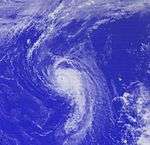  | |
| Duration | August 26 – September 3 |
|---|---|
| Peak intensity | 110 km/h (70 mph) (10-min) 970 hPa (mbar) |
Also on August 24, another area of disturbed weather was spoted within the monsoon trough, which was displaced form its normal position. Thunderstorm activity gradually improved in organization,[4] and at 06:00 UTC on August 26, the JMA designated the system a tropical depression. The depression was upgraded into a tropical storm three days later by the JMA.[3] Interaction with Elsie - the storms at one point were within 460 mi (740 km) of each other - caused the cyclone to track eastward. Dvorak estimates of T3.0/80 km/h (50 mph) prompted the JTWC to upgrade it to a tropical storm on August 30,[4] with the JMA upgrading it to a severe tropical storm that evening.[3] Interaction with Elsie failed to stop Fabian from intensifying, and at 06:00 UTC on September 1, the JTWC upgraded Fabian into a typhoon, only for the storm to veer north shortly thereafter.[4] On September 2, the JMA and the JTWC estimated that Fabian attained peak intensities of 115 km/h (70 mph) and 135 km/h (85 mph) respectively.[4][3] Accelerating, Fabian began to encounter stronger westerly wind shear, which led to weakening. The JTWC declared Fabian an extratropical cyclone at 06:00 UTC on September 32,[4] with the JMA doing the same on the next day.[3]
Tropical Storm Gay
| Tropical storm (JMA) | |
| Tropical storm (SSHWS) | |
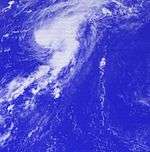  | |
| Duration | September 2 – September 4 |
|---|---|
| Peak intensity | 75 km/h (45 mph) (10-min) 995 hPa (mbar) |
Gay was short-lived.
Typhoon Uleki
| Typhoon (JMA) | |
| Category 2 typhoon (SSHWS) | |
 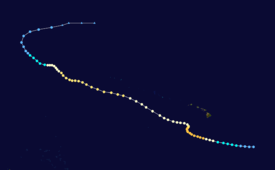 | |
| Duration | September 8 ((entered basin)) – September 16 |
|---|---|
| Peak intensity | 130 km/h (80 mph) (10-min) 945 hPa (mbar) |
Uleki had developed on August 28 well to the southeast of Hawai'i and become a hurricane in the north-central Pacific before crossing the International Dateline. At 00:00 UTC on September 8, the CPHC transferred warning responsibility of Uleki to the Joint Typhoon Warning Center (JTWC) and the storm was subsequently referred to as a typhoon. Three hours later Uleki made its closest approach to Midway Atoll, passing 200 mi (320 km) to the south. Shortly thereafter the system crossed the International Dateline and the Japan Meteorological Agency (JMA) also began advising on the system.[6][7] The JMA estimated Uleki to have had a pressure of 945 mb (hPa; 27.91 inHg) at this time; however, this value was derived from satellite estimates rather than direct measurements.[7] Uleki maintained this strength through September 10 as it continued on its west-northwest course. On that day, the typhoon again entered a region of weak steering currents between two anticyclones within the subtropical ridge. A trough approaching from the west was forecast to prompt Uleki to turn east; however, the typhoon maintained a general northwest motion in a stair-stepped fashion. Increasing wind shear and cooler air soon imparted weakening,[8] and Uleki degraded to a tropical storm by September 12.[7]
Continued effects from shear stripped the cyclone of all deep convection and by September 14 only a band of cirrus clouds remained in association with Uleki. The JTWC issued their final warning on the system at 00:00 UTC that day accordingly.[8] The JMA maintained the system as a tropical depression as the former typhoon began turning to the east. Uleki later transitioned into an extratropical cyclone on September 16 as it accelerated to the east. The system dissipated the following day near the International Dateline, far from any major landmasses.[7]
Typhoon Hal
| Typhoon (JMA) | |
| Category 3 typhoon (SSHWS) | |
 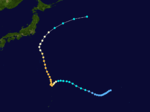 | |
| Duration | September 8 – September 17 |
|---|---|
| Peak intensity | 155 km/h (100 mph) (10-min) 945 hPa (mbar) |
This system first became a tropical depression well to the southeast of Japan, while moving to the northwest. Hal intensified into a tropical storm on September 9, and then turned to the southeast on September 10. Typhoon intensity was reached on September 11. Early on September 12, Hal sharply recurved, first turning to the north-northwest and eventually northeast on September 15. Accelerating northeastward, Hal became an extratropical cyclone on September 17. While the center never crossed land, two people in Honshu were reported missing with 13 others injured. As an extratropical cyclone, Hal restrengthened. By late on September 18, its central pressure had fallen to 950.0 hectopascals (28.05 inHg) and the storm was causing winds up to 72 knots (133 km/h). After peaking in strength, Hal moved through the eastern Bering Sea on September 19 and into Alaska on September 20. The weakening low moved on an anticyclonic path through southern Alaska before emerging into the Gulf of Alaska on September 23. The cyclone drifted erratically southward, dissipating in the Gulf of Alaska on September 25.[9]
Severe Tropical Storm Irma
| Severe tropical storm (JMA) | |
| Tropical storm (SSHWS) | |
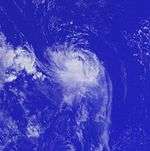  | |
| Duration | September 11 – September 17 |
|---|---|
| Peak intensity | 100 km/h (65 mph) (10-min) 990 hPa (mbar) |
Irma lasted five days.
Tropical Storm Jeff (Lusing)
| Tropical storm (JMA) | |
| Tropical storm (SSHWS) | |
  | |
| Duration | September 11 – September 17 |
|---|---|
| Peak intensity | 85 km/h (50 mph) (10-min) 994 hPa (mbar) |
Jeff moved east then northeast away from land.
Severe Tropical Storm Kit (Maring)
| Severe tropical storm (JMA) | |
| Tropical storm (SSHWS) | |
  | |
| Duration | September 19 – September 22 |
|---|---|
| Peak intensity | 100 km/h (65 mph) (10-min) 980 hPa (mbar) |
Tropical Storm Kit formed from an area of disturbed weather 300 miles east of Manila. A depression formed on the 19th of September and strengthened into Tropical Storm Kit shortly before making landfall on the extreme northern tip of Luzon Island. Kit continued towards the northwest and made landfall 120 miles northeast of Hong Kong. Widespread flooding was reported and 3 people were killed in Guangdong Province in China.[2]
Severe Tropical Storm Lee (Ningning)
| Severe tropical storm (JMA) | |
| Tropical storm (SSHWS) | |
  | |
| Duration | September 19 – September 25 |
|---|---|
| Peak intensity | 95 km/h (60 mph) (10-min) 990 hPa (mbar) |
Lee recurved out at sea.
Tropical Storm Mamie
| Tropical storm (JMA) | |
| Tropical storm (SSHWS) | |
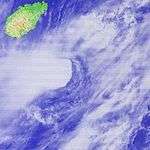  | |
| Duration | September 19 – September 24 |
|---|---|
| Peak intensity | 85 km/h (50 mph) (10-min) 990 hPa (mbar) |
Mamie was a weak tropical storm in the South China Sea.
Super Typhoon Nelson (Paring)
| Typhoon (JMA) | |
| Category 5 super typhoon (SSHWS) | |
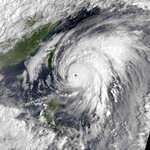  | |
| Duration | September 30 – October 8 |
|---|---|
| Peak intensity | 185 km/h (115 mph) (10-min) 915 hPa (mbar) |
Nelson was a super typhoon.
Typhoon Odessa (Seniang)
| Typhoon (JMA) | |
| Category 2 typhoon (SSHWS) | |
  | |
| Duration | October 8 – October 16 |
|---|---|
| Peak intensity | 130 km/h (80 mph) (10-min) 965 hPa (mbar) |
Odessa was a typhoon in the Philippine Sea.
Severe Tropical Storm Pat (Toyang)
| Severe tropical storm (JMA) | |
| Category 1 typhoon (SSHWS) | |
  | |
| Duration | October 16 – October 22 |
|---|---|
| Peak intensity | 110 km/h (70 mph) (10-min) 980 hPa (mbar) |
Pat moved through the Philippines.
Typhoon Ruby (Unsang)
| Typhoon (JMA) | |
| Category 4 typhoon (SSHWS) | |
 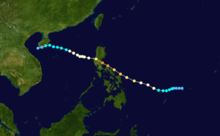 | |
| Duration | October 20 – October 28 |
|---|---|
| Peak intensity | 140 km/h (85 mph) (10-min) 950 hPa (mbar) |
Typhoon Ruby, which developed east of the Philippines on October 20, rapidly intensified to a 145 mph typhoon while approaching central Luzon. It hit on the 24th, and rapidly weakened to a minimal typhoon over the island. Ruby, with its disrupted circulation, remained weak over the South China Sea, and land interaction with Vietnam caused it to dissipate on the 28th. Ruby caused over 300 fatalities, with widespread flooding and damage over its track. Ruby brought heavy rains and a 12-foot storm surge to Guam and the Marianas Islands. On Luzon, the storm's 140 mph (220 km/h) winds caused tremendous damage to the town of Siniloan. In the Polillo Islands, east of Manila, Ruby spawned rare tornadoes that leveled homes. In the northern part of the Philippines, many fishing boats were wrecked by 30–40 foot waves, and 32 more people drowned.[10] Damage in the Philippines totaled 5.64 billion Philippine Pesos (1989 pesos).[11]
The passenger ferry the MV Doña Marilyn was in the Visayan Sea when the storm struck the vessel. The storm caused the ferry to list to the starboard until one of the decks was below the water, causing the ship to fill up rapidly. The passengers and crew tried to save the ship, but to no avail. The Doña Marilyn sank stern first taking 389 people with it. Only 147 people survived by clinging to life rafts.
Typhoon Skip (Yoning)
| Typhoon (JMA) | |
| Category 4 typhoon (SSHWS) | |
  | |
| Duration | November 3 – November 12 |
|---|---|
| Peak intensity | 150 km/h (90 mph) (10-min) 950 hPa (mbar) |
Just 2 weeks after Ruby hit Luzon, Skip, which formed on November 3, hit the central Philippines as a 145 mph typhoon. Ruby reached the South China Sea on the 7th, and steadily weakened until dissipation on the 12th. Skip was responsible for killing 104 people (with 95 missing) and extensive damage to the coconut, rice, and sugar crops.[12]
Severe Tropical Storm Tess (Welpring)
| Severe tropical storm (JMA) | |
| Category 1 typhoon (SSHWS) | |
 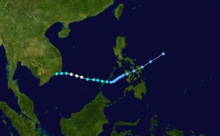 | |
| Duration | November 1 – November 6 |
|---|---|
| Peak intensity | 110 km/h (70 mph) (10-min) 975 hPa (mbar) |
After passing through the Philippines, a tropical disturbance organized in the South China Sea into a tropical depression late on the morning of November 4. Turning westward and strengthening, the cyclone became a tropical storm later that day, and then a typhoon by late November 5. It moved into Vietnam on November 6 and quickly weakened, becoming the only tropical cyclone that season to make landfall in the country. Its remains later moved across the Mekong River delta.[13]
Tropical Storm Val (Apiang)
| Tropical storm (JMA) | |
| Tropical storm (SSHWS) | |
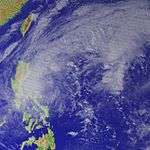  | |
| Duration | December 21 – December 25 |
|---|---|
| Peak intensity | 85 km/h (50 mph) (10-min) 992 hPa (mbar) |
Val was a weak tropical storm in the Philippine Sea.
Storm names
During the season 26 named tropical cyclones developed in the Western Pacific and were named by the Joint Typhoon Warning Center, when it was determined that they had become tropical storms. These names were contributed to a revised list which started on 1979.
| Roy | Susan | Thad | Vanessa | Warren | Agnes | Bill | Clara | Doyle | Elsie | Fabian | Gay | Hal |
| Irma | Jeff | Kit | Lee | Mamie | Nelson | Odessa | Pat | Ruby | Skip | Tess | Val |
Philippines
| Asiang | Biring | Konsing | Ditang | Edeng |
| Gloring | Huaning | Isang | Lusing | Maring |
| Ningning | Osang | Paring | Reming | Seniang |
| Toyang | Unsang | Welpring | Yoning | |
| Auxiliary list | ||||
|---|---|---|---|---|
| Apiang | ||||
| Basiang (unused) | Kayang (unused) | Dorang (unused) | Enang (unused) | Grasing (unused) |
The Philippine Atmospheric, Geophysical and Astronomical Services Administration uses its own naming scheme for tropical cyclones in their area of responsibility. PAGASA assigns names to tropical depressions that form within their area of responsibility and any tropical cyclone that might move into their area of responsibility. Should the list of names for a given year prove to be insufficient, names are taken from an auxiliary list, the first 6 of which are published each year before the season starts. Names not retired from this list will be used again in the 1992 season. This is the same list used for the 1984 season. PAGASA uses its own naming scheme that starts in the Filipino alphabet, with names of Filipino female names ending with "ng" (A, B, K, D, etc.). Names that were not assigned/going to use are marked in gray.
Retirement
Because Typhoons Unsang and Yoning made extensive damage within the Philippines, the PAGASA later retired the names Unsang and Yoning and was replaced by Ulpiang and Yerling for the 1992 season.
Season effects
This is a table of all of the storms that have formed in the 1987 Pacific typhoon season. It includes their duration, names, affected areas, damages, and death totals. Deaths in parentheses are additional and indirect (an example of an indirect death would be a traffic accident), but were still related to that storm. Damage and deaths include totals while the storm was extratropical, a wave, or a low, and all of the damage figures are in 1986 USD. Names listed in parentheses were assigned by PAGASA.
| Name | Dates active | Peak classification | Sustained wind speeds |
Pressure | Areas affected | Damage (USD) |
Deaths | Refs |
|---|---|---|---|---|---|---|---|---|
| Roy (Asiang) | January 7 – 19 | Typhoon | 155 km/h (100 mph) | 940 hPa (27.76 inHg) | Marshall Islands, Mariana Islands, Caroline Islands, Philippines | $28.5 million | 2 | |
| Susan (Biring) | May 28 – June 3 | Typhoon | 120 km/h (75 mph) | 975 hPa (28.79 inHg) | Philippines, Taiwan, Ryukyu Islands | None | 6 | |
| 03W (Konsing) | June 3 – 6 | Tropical storm | 65 km/h (40 mph) | 1000 hPa (29.53 inHg) | Philippines, Taiwan | None | None | |
| Thad (Ditang) | June 17 – 25 | Typhoon | 130 km/h (80 mph) | 970 hPa (28.64 inHg) | Philippines | None | None | |
| TD | June 22 – 26 | Tropical depression | Not specified | 1004 hPa (29.65 inHg) | None | None | None | |
| Vanessa (Edeng) | June 26 – 29 | Severe tropical storm | 100 km/h (90 mph) | 990 hPa (29.23 inHg) | Philippines, South China | None | None | |
| Gloring | July 6 – 9 | Tropical depression | 45 km/h (30 mph) | 1000 hPa (29.53 inHg) | Taiwan | None | None | |
| Warren (Huaning) | July 12 – 20 | Typhoon | 165 km/h (105 mph) | 940 hPa (27.76 inHg) | Mariana Islands, Caroline Islands, Philippines, Taiwan, China | $10 million | 17 | |
| TD | July 25 – 28 | Tropical depression | Not specified | 998 hPa (29.47 inHg) | None | None | None | |
| Agnes | July 27 – August 1 | Severe tropical storm | 95 km/h (60 mph) | 975 hPa (28.79 inHg) | None | None | None | |
| TD | July 29 – 30 | Tropical depression | Not specified | 1002 hPa (29.59 inHg) | None | None | None | |
| Eight | August 1 – 3 | Tropical storm | 65 km/h (40 mph) | 998 hPa (29.47 inHg) | Japan | None | None | |
| TD | August 1 – 3 | Tropical depression | Not specified | 1002 hPa (29.59 inHg) | South China | None | None | |
| TD | August 4 – 6 | Tropical depression | Not specified | 1004 hPa (29.65 inHg) | Ryukyu Islands | None | None | |
| Bill (Isang) | August 4 – 9 | Tropical storm | 85 km/h (50 mph) | 985 hPa (29.09 inHg) | Ryukyu Islands, East China | None | 110 | |
| Clara | August 5 – 16 | Tropical storm | 75 km/h (45 mph) | 994 hPa (29.35 inHg) | None | None | None | |
| TD | August 6 – 16 | Tropical depression | Not specified | 1000 hPa (29.53 inHg) | Japan | None | None | |
| TD | August 9 | Tropical depression | Not specified | 1000 hPa (29.53 inHg) | None | None | None | |
| TD | August 10 – 13 | Tropical depression | Not specified | 1002 hPa (29.59 inHg) | South China | None | None | |
| TD | August 12 – 13 | Tropical depression | Not specified | 1002 hPa (29.59 inHg) | Japan | None | None | |
| TD | August 12 – 14 | Tropical depression | Not specified | 1002 hPa (29.59 inHg) | Japan | None | None | |
| Eleven | August 13 – 18 | Tropical storm | 65 km/h (40 mph) | 1000 hPa (29.53 inHg) | Japan | None | None | |
| Doyle | August 13 – 24 | Typhoon | 165 km/h (105 mph) | 930 hPa (27.46 inHg) | None | None | None | |
| TD | August 13 | Tropical depression | Not specified | 1004 hPa (29.65 inHg) | Japan | None | None | |
| Thirteen | August 13 – 16 | Tropical storm | 65 km/h (40 mph) | 1000 hPa (29.53 inHg) | Japan | None | None | |
| TD | August 15 – 16 | Tropical depression | Not specified | 1010 hPa (29.83 inHg) | None | None | None | |
| TD | August 18 | Tropical depression | Not specified | 1006 hPa (29.71 inHg) | None | None | None | |
| Fabian | August 24 – September 3 | Severe tropical storm | 110 km/h (70 mph) | 970 hPa (28.64 inHg) | Japan | None | None | |
| Elsie | August 26 – September 1 | Tropical storm | 85 km/h (50 mph) | 992 hPa (29.29 inHg) | None | None | None | |
| Gay | September 2 – 4 | Tropical storm | 75 km/h (45 mph) | 996 hPa (29.41 inHg) | None | None | None | |
| TD | September 3 – 6 | Tropical depression | Not specified | 1010 hPa (29.83 inHg) | None | None | None | |
| Uleki | September 8 – 16 | Typhoon | 130 km/h (80 mph) | 945 hPa (27.91 inHg) | Wake Island | None | None | |
| Hal | September 8 – 17 | Typhoon | 155 km/h (105 mph) | 945 hPa (27.91 inHg) | Japan | None | None | |
| TD | September 9 – 10 | Tropical depression | Not specified | 1008 hPa (29.77 inHg) | Japan | None | None | |
| Irma | September 11 – 17 | Severe tropical storm | 100 km/h (65 mph) | 990 hPa (29.23 inHg) | None | None | None | |
| Jeff (Lusing) | September 11 – 17 | Tropical storm | 85 km/h (50 mph) | 994 hPa (29.35 inHg) | None | None | None | |
| Kit (Maring) | September 19 – 22 | Severe tropical storm | 100 km/h (65 mph) | 980 hPa (28.94 inHg) | Philippines, South China | None | 3 | |
| Lee (Ningning) | September 19 – 25 | Severe tropical storm | 95 km/h (60 mph) | 990 hPa (29.23 inHg) | Mariana Islands, Ryukyu Islands | None | None | |
| Mamie | September 19 – 24 | Tropical storm | 85 km/h (50 mph) | 990 hPa (29.23 inHg) | South China, Vietnam | None | None | |
| TD | September 23 – 24 | Tropical depression | Not specified | 1002 hPa (29.59 inHg) | None | None | None | |
| TD | September 28 – October 3 | Tropical depression | 45 km/h (30 mph) | 1000 hPa (29.53 inHg) | Philippines, Vietnam, South China | None | None | |
| Nelson (Paring) | September 30 – October 9 | Typhoon | 185 km/h (115 mph) | 915 hPa (27.02 inHg) | Philippines, Japan | None | None | |
| Osang | October 1 – 2 | Tropical depression | Not specified | 1004 hPa (29.65 inHg) | Philippines | None | None | |
| TD | October 6 – 7 | Tropical depression | Not specified | 1002 hPa (29.59 inHg) | None | None | None | |
| Twenty-five | October 7 – 10 | Tropical storm | 85 km/h (50 mph) | 992 hPa (29.29 inHg) | Vietnam | None | None | |
| Reming | October 8 | Tropical storm | 65 km/h (40 mph) | 1006 hPa (29.71 inHg) | Philippines | None | None | |
| Odessa (Seniang) | October 8 – 19 | Typhoon | 130 km/h (80 mph) | 965 hPa (28.50 inHg) | Mariana Islands | None | None | |
| TD | October 15 – 17 | Tropical depression | Not specified | 1004 hPa (29.65 inHg) | Vietnam, Cambodia, Thailand | None | None | |
| Pat (Toyang) | October 17 – 23 | Severe tropical storm | 110 km/h (70 mph) | 980 hPa (28.94 inHg) | Philippines, China, Vietnam | None | None | |
| Ruby (Unsang) | October 20 – 29 | Typhoon | 140 km/h (85 mph) | 950 hPa (28.05 inHg) | Philippines, South China | $311 million | 288 | |
| Tess (Welpring) | November 1 – 7 | Severe tropical storm | 110 km/h (70 mph) | 975 hPa (28.79 inHg) | Philippines, Vietnam | $22.4 million | 123 | |
| Skip (Yoning) | November 3 – 12 | Typhoon | 140 km/h (85 mph) | 950 hPa (28.05 inHg) | Philippines, Vietnam | $132 million | 237 | |
| TD | December 11 – 12 | Tropical depression | Not specified | 1004 hPa (29.65 inHg) | None | None | None | |
| Val (Apiang) | December 22 – 27 | Tropical storm | 85 km/h (50 mph) | 992 hPa (29.29 inHg) | Philippines | None | None | |
| Season aggregates | ||||||||
| 52 systems | January 7 – December 27 | 185 km/h (115 mph) | 915 hPa (27.02 inHg) | >$504 million | >786 | |||
See also
- 1988 Pacific hurricane season
- 1988 Atlantic hurricane season
- 1988 North Indian Ocean cyclone season
- Southern Hemisphere tropical cyclone seasons: 1987-88, 1988-89
References
- ↑ Gary Padgett. May 2003 Tropical Cyclone Summary. Archived 2010-12-20 at WebCite Retrieved 2006-08-26.
- 1 2 3 Joint Typhoon Warning Center. Retrieved on 2007-12-26.
- 1 2 3 4 5 6 7 8 9 10 11 12 13 14 15 16 17 18 19 20 21 22 23 24 25 26 27 28 29 30 31 32 33 34 35 Japan Meteorological Agency (October 10, 1992). RSMC Best Track Data – 1980–1989 (.TXT) (Report). Retrieved July 19, 2017.
- 1 2 3 4 5 6 7 8 9 10 11 12 13 14 15 16 17 18 19 20 21 22 23 24 25 26 27 28 29 30 31 32 33 34 35 36 37 38 39 40 41 42 Joint Typhoon Warning Center; Naval Pacific Meteorology and Oceanography Center (1989). Annual Tropical Cyclone Report: 1987 (PDF) (Report). United States Navy, United States Air Force. Retrieved July 19, 2017.
- ↑ Joint Typhoon Warning Center. Tropical Storm Bill. Retrieved on 2007-01-19.
- ↑ "The 1988 Central Pacific Tropical Cyclone Season". Central Pacific Hurricane Center. Honolulu, Hawaii: National Oceanic and Atmospheric Administration. 2014. August 28-September 7, 1988 (Hurricane Uleki). Retrieved August 20, 2014.
- 1 2 3 4 "Typhoon 198817 (ULEKI) - Detailed Track Information". Japan Meteorological Agency. National Institute of Informatics. 1989. Retrieved August 20, 2014.
- 1 2 Cpt. John M. Rogers and Lt. Douglas H. Scovil Jr. (1989). "Typhoon Uleki (01C)". Annual Tropical Cyclone Report (PDF). Joint Typhoon Warning Center (Report). United States Navy. pp. 88–91. Retrieved August 20, 2014.
- ↑ Richard M. DeAngelis, ed. (Winter 1989). Mariners Weather Log. National Oceanic and Atmospheric Administration. 33 (1): 48–49, 56.
- ↑ Joint Typhoon Warning Center. Typhoon Ruby. Archived June 7, 2011, at the Wayback Machine. Retrieved on 2007-01-19.
- ↑ Philippine Atmospheric Geophysical and Astronomical Services Administration. Most Destructive Tropical Cyclones for Month of October (1948-2000). Archived May 11, 2004, at the Wayback Machine. Retrieved on 2007-02-04.
- ↑ Joint Typhoon Warning Center. Typhoon Skip. Archived 2011-06-07 at the Wayback Machine. Retrieved on 2007-01-19.
- ↑ Joint Typhoon Warning Center. Typhoon Tess. Retrieved on 2007-01-19.
External links
- Satellite movie of 1988 Pacific typhoon season
- Japan Meteorological Agency
- Joint Typhoon Warning Center.
- China Meteorological Agency
- National Weather Service Guam
- Hong Kong Observatory
- Macau Meteorological Geophysical Services
- Korea Meteorological Agency
- Philippine Atmospheric, Geophysical and Astronomical Services Administration
- Taiwan Central Weather Bureau
